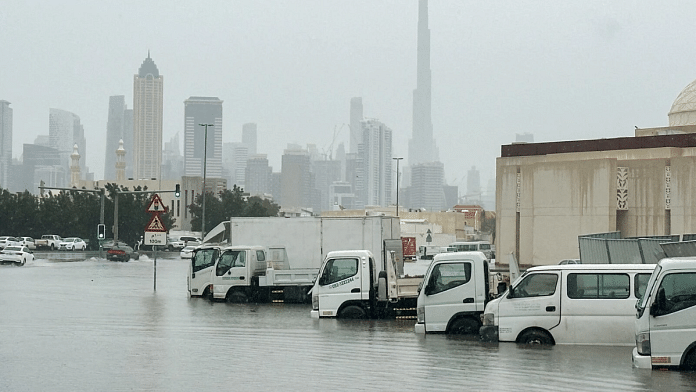Severe rainstorms and floods swamped the Gulf countries, including UAE, Bahrain, Qatar, Saudi Arabia and Oman in April. In Dubai, most of the rain fell on Monday, the 15th of April, and exceeded all previous records of daily rainfall in the last 75 years, when records began. At least 20 people died in Oman and four died in the UAE.
A record 254mm of rain dropped in Al Ain, more than the country’s average in a year. The deluge forced Dubai International Airport, the second busiest in the world, to cancel hundreds of flights.
The floods — which may have been exacerbated by climate change — caused damage thought to be worth hundreds of millions of dollars to homes and businesses; they disrupted the lives of millions.
Counting the cost of floods and extreme weather
While the economic impact of losses in UAE and Oman is not yet clear, the UAE government has already announced a $540 million fund to support those affected by floods. Insurers in the country expect severe ramifications. Early signs point to significant disruptions across several sectors, and tourism, the lifeblood of Dubai’s economy, will likely take a hit.
The April floods in the Gulf are part of a wider emerging global pattern. The economic ramifications of climate change are far-reaching. Global losses from extreme weather events reached £360bn in 2021 (about 0.4% of the world’s GDP). The State of the Climate in Asia 2023 report highlighted that Asia remained the world’s most disaster-hit region from weather, climate and water-related hazards in 2023. Floods and storms caused the highest number of reported casualties and economic losses, while the impact of heat waves became more severe.
Recent analysis shows climate change could cut global GDP by 17% by 2050. The cost of tackling climate change is just a sixth of this — and a key facet of this is protecting critical infrastructure from extreme weather events, like the April floods.
Protecting infrastructure from floods
Climate change amplifies the vulnerabilities of infrastructure systems. In hot and dry climates like those of the Arabian Gulf, rainfall is infrequent and the city’s infrastructure often fails to handle extreme weather events. Roads, bridges, ports and airports are growing increasingly exposed to more frequent and severe weather events, leading to physical damage, disruptions in supply chains and increased maintenance costs.
The flooding in the Gulf illustrated that urban engineering is failing a significant climate change test, especially in rich Gulf countries known for building skyscrapers and buildings of the future. Addressing the impacts of climate change on infrastructure, therefore, requires a multifaceted approach.
7 ways to bolster climate mitigation in the Gulf
A comprehensive approach tailored to the specific challenges and characteristics of the region will contribute to the successful management of heavy rainfall and other extreme weather events in the future.
Investing in resilient infrastructure designs that can withstand extreme weather events is crucial. Integrating climate risk assessments into infrastructure planning and development processes can help identify vulnerabilities and prioritize adaptation measures. Embracing nature-based solutions, such as green infrastructure and coastal restoration projects, can enhance resilience while providing additional co-benefits for ecosystems and communities.
A combination of adaptation and resilience strategies is necessary to effectively address the challenges posed by extreme weather events. Adaptation strategies focus on enhancing resilience and reducing vulnerability to flooding, rainstorms while mitigation strategies aim to reduce the magnitude and impact of flooding events.
Here are seven key recommendations to consider:
1. Build climate resilience into cities by default: This involves designing and constructing buildings and transportation systems that can withstand extreme weather events such as heavy rainfall and flooding.
2. Implement effective drainage systems: Installing and maintaining proper drainage systems can help prevent water accumulation and reduce the risk of flooding during intense rainfall events.
3. Implement sustainable stormwater management: Constructing rainwater harvesting systems, retention ponds and permeable surfaces to reduce runoff and increase water infiltration.
4. Promote sustainable urban planning: This includes incorporating green spaces, water retention areas and permeable surfaces into urban areas to absorb excess rainfall and reduce the risk of flooding.
5. Implement early warning systems: Developing and implementing advanced monitoring and early warning systems can help detect and predict extreme weather events, providing valuable time for evacuation and emergency preparedness.
6. Put in place environmental regulations and assessments: Ensure strict environmental impact assessments are conducted for all major projects, incorporating flood risk analysis, and requiring appropriate mitigation strategies.
7. Research and collaboration: Invest in research on climate change impacts specific to the region. Strengthen international collaboration to share knowledge and data availability in climate change mitigation.
A climate crossroads in the Gulf and beyond
As we confront the challenges of climate change, it is imperative to recognize the interconnectedness of infrastructure and the economy in shaping our collective resilience and prosperity. By integrating specific mitigation and adaptation measures, the Gulf can enhance its resilience to flooding and reduce the long-term impact of these extreme weather events on communities, infrastructure and ecosystems.
Looking beyond immediate recovery, the rich oil and gas economy-based countries in the Gulf, including the UAE, Oman, Saudi Arabia, Qatar, Kuwait and Bahrain, have an opportunity to re-evaluate their infrastructure resilience to climate change. The recent downpour and aftermath could serve as a wake-up call, a reminder that even the most advanced economies are not immune to nature’s disruptive power. The focus now should be on a swift recovery, reassessing vulnerabilities and building a more resilient future for the region.
We can create a world where infrastructure serves as a foundation for economic growth, environmental stewardship and societal well-being in the face of climate change.
This article was first published in the World Economic Forum.
Also read: What is ‘Project Nilgiri Tahr, Tamil Nadu’s multi-pronged initiative to save state anima



